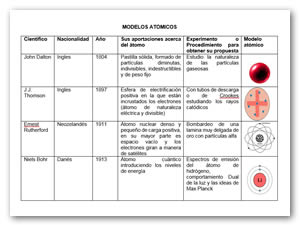Evolución del modelo atómico
Resumen
Los filósofos griegos Demócrito y Leucipo creían que la materia estaba formada por partículas indivisibles llamadas átomos, esta idea prevaleció hasta fines del siglo XVIII, tiempo después resurgió el termino átomo y se establecieron las teorías y modelos atómicos de Dalton, Thomson, Rutherford, Bohr, Sommerfeld, y el modelo de la Mecánica Cuántica (tabla anexa) explicando el concepto del átomo, su reacción química y sus características. En la actualidad el átomo se define como la partícula más pequeña de un elemento, divisible, formado de partículas subatómicas (electrón, neutrón, protón), formado de un núcleo atómico en el que se encuentran los protones y los neutrones que conforman la masa atómica y de niveles de energía u orbitales en el que los electrones giran con energía especifica.
Palabras clave: Materia, átomos, teorías atómicas, modelos atómicos, reacción química, partícula, divisible, partículas subatómicas, electrón, neutrón, protón, núcleo atómico, niveles de energía.
Abstract
The Greek philosophers Democritus and Leucippus believed that matter was composed of indivisible particles called atoms, this idea prevailed until the end of the 18th century, time after resurfaced the term atom and stablished the atomic theories as well as the atomic models of Dalton, Thomson, Rutherford, Bohr, Sommerfeld and quantum mechanics model (attached table) explaining the concept of the atom, of its chemical reaction and its characteristics. Actually the atom is defined as the smallest particle of an element, divisible, formed of subatomics particle (electron, neutron, proton), it is formed of an atomic nucleus, in which are found the protons and neutrons that are part of the atomic mass and of the levels of energy or atomic orbitals in which the electrons spin with specific energy.
Keywords: Matter, atom, Atomic theories, Atomic models, chemical reaction, particle, divisible, subatomic particles, electron, neutron, proton, atomic nucleus, energy levels
Referencias
Ocampo, G. A. (1992). Fundamentos de Química 1. México: Publicaciones Cultural.
Vázquez, D. N. (2012). Química 1. México: Esfínge. https://www.google.com.mx/search?as_st=y&tbm=isch&hl=es&as_q=ato mic+models&as_epq=&as_oq=&as_eq=&cr=&as_sitesearch=&safe= images&tbs=sur:f
[a]Profesor de Investigación de la Escuela Preparatoria Número 4
Compartir en:
